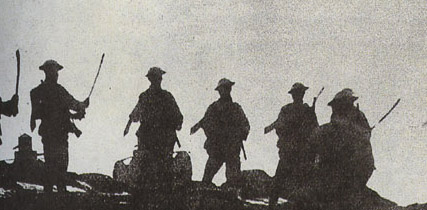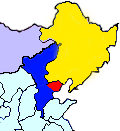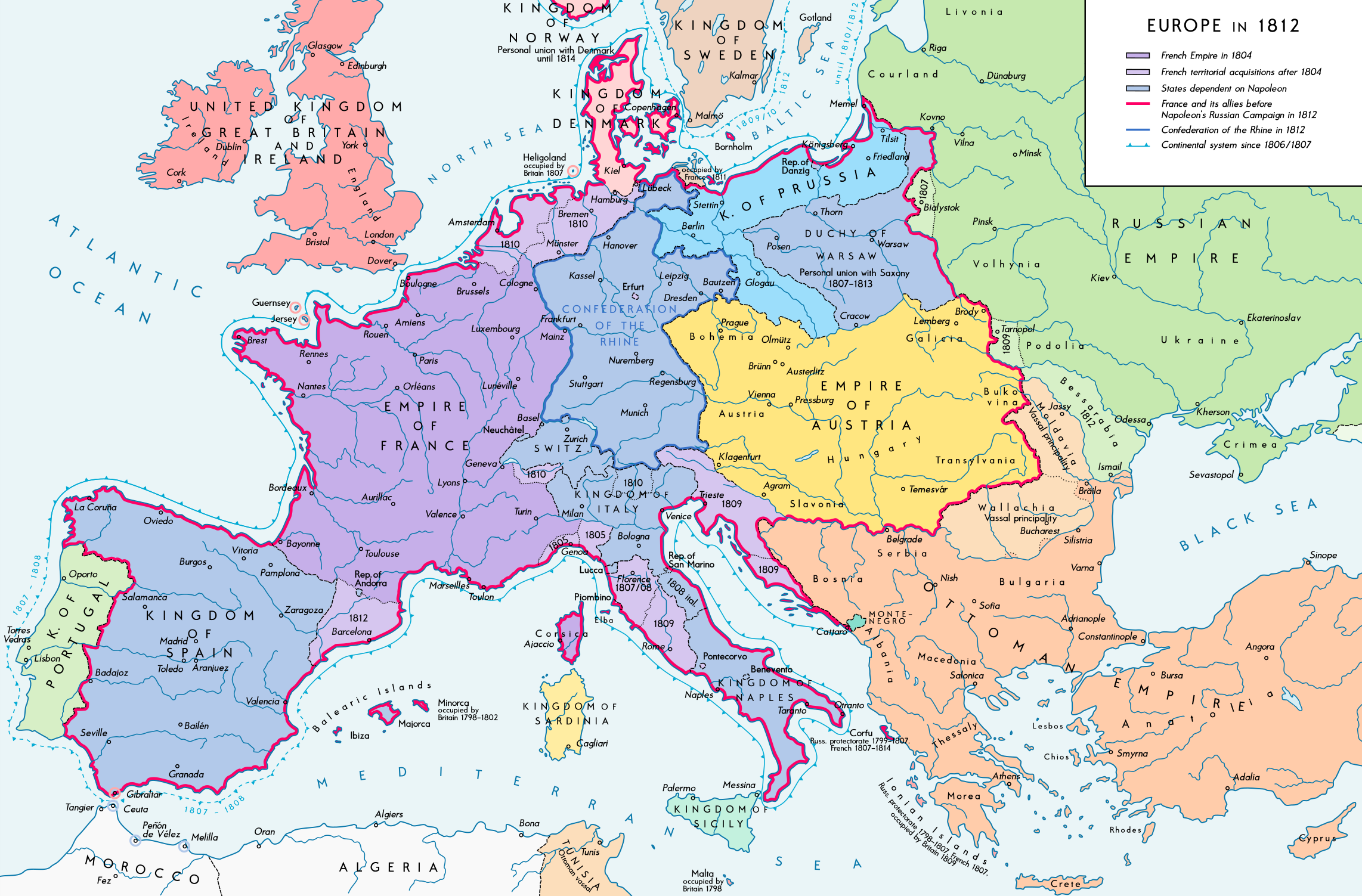|
Actions In Inner Mongolia (1933–1936)
The Inner Mongolian campaign in the period from 1933 to 1936 were part of the ongoing invasion of northern China by the Empire of Japan prior to the official start of hostilities in the Second Sino-Japanese War. In 1931, the invasion of Manchuria secured the creation of the puppet state of Manchukuo and in 1933, Operation Nekka detached the province of Jehol from the Republic of China. Blocked from further advance south by the Tanggu Truce, the Imperial Japanese Army turned its attention west, towards the Inner Mongolian provinces of Chahar and Suiyuan, with the goal of establishing a northern China buffer state. In order to avoid overt violation of the Truce, the Japanese government used proxy armies in these campaigns while Chinese resistance was at first only provided by Anti-Japanese resistance movement forces in Chahar. The former included in the Inner Mongolian Army, the Manchukuo Imperial Army, and the Grand Han Righteous Army. Chinese government forces were overtly hos ... [...More Info...] [...Related Items...] OR: [Wikipedia] [Google] [Baidu] |
Chahar (province)
Chahar ( mn, , Чахар; ), also known as Chaha'er, Chakhar or Qahar, was a province of the Republic of China in existence from 1912 to 1936, mostly covering territory in what is part of Eastern Inner Mongolia. It was named after the Chahar Mongols. Administration and history Chahar Province is named after the Chahar, a tribal group of the Mongols who live in that area. The area was controlled (in part or fully) by various empires that ruled over China's north including the Han, Tang, Liao, and Jin dynasties. After the unification of the Mongol tribes under Genghis Khan, the area came under Yuan rule. After the Yuan dynasty (1271–1368), the area was a battleground between the Ming dynasty and Northern Yuan. Then the Chahar tribe became the personal appanage of the monarchs of the Northern Yuan dynasty since the reign of Batumongke Dayan Khan (r. 1479–1517). By the Qing dynasty (1644–1912), Chahar was a "Zhangyuan Special Region" (), although Yao Xiguang () proposed ... [...More Info...] [...Related Items...] OR: [Wikipedia] [Google] [Baidu] |
Northern And Southern China
Northern China () and Southern China () are two approximate regions within China. The exact boundary between these two regions is not precisely defined and only serve to depict where there appears to be regional differences between the climates and localities of northern regions of China vs southern regions of China. Nevertheless, regional differences in culture and language have historically fostered a number of local identities. Extent Often used as the geographical dividing line between northern and southern China is the Qinling–Huaihe Line (lit. Qin Mountains–Huai River Line). This line approximates the 0 °C January isotherm and the isohyet in China. Culturally, however, the division is more ambiguous. In the eastern provinces like Jiangsu and Anhui, the Yangtze River may instead be perceived as the north–south boundary instead of the Huai River, but this is a recent development. There is an ambiguous area, the region around Nanyang, Henan, that lies in th ... [...More Info...] [...Related Items...] OR: [Wikipedia] [Google] [Baidu] |
Defense Of The Great Wall
The defense of the Great Wall () (January 1 – May 31, 1933) was a campaign between the armies of Republic of China and Empire of Japan, which took place before the Second Sino-Japanese War officially commenced in 1937 and after the Japanese invasion of Manchuria in 1931. It is known in Japanese as and in many English sources as the First Battle of Hopei. During this campaign, Japan successfully captured the Inner Mongolian province of Rehe from the Chinese warlord Zhang Xueliang, and incorporated it into the newly created state of Manchukuo, whose southern frontier was thus extended to the Great Wall of China. Battle of Shanhai Pass Shanhaiguan is the fortified eastern end of the Great Wall of China, where the Great Wall meets the ocean. Per the terms of the 1901 Boxer Rebellion accord, the Imperial Japanese Army maintained a small garrison of around 200 men at Shanhaiguan. On the night of 1 January 1933, the Japanese garrison commander staged an "incident" by exploding a few ... [...More Info...] [...Related Items...] OR: [Wikipedia] [Google] [Baidu] |
North China Buffer State Strategy
The () is the general term for a series of political manoeuvrings Japan undertook in the five provinces of northern China, Hebei, Chahar, Suiyuan, Shanxi, and Shandong. It was an operation to detach all of northern China from the power of the Nationalist Government and put it under Japanese control or influence. In China the affair is referred to as the “North China Incident” corresponding only to the time between the series of "North China Autonomy Movements" orchestrated by the Japanese army since May 1935 and the founding of the Hebei–Chahar Political Council under Song Zheyuan in December. It is recognized as ranking alongside the Manchurian Incident, the Shanghai Incident, and the Marco Polo Bridge Incident. Development of the strategy Between the winter of 1934 and January 1935 small-scale clashes between the Chinese and Japanese armies were occurring frequently along the cease-fire lines established by the Tanggu Truce and the Japanese army was coming to the v ... [...More Info...] [...Related Items...] OR: [Wikipedia] [Google] [Baidu] |
Inner Mongolia
Inner Mongolia, officially the Inner Mongolia Autonomous Region, is an autonomous region of the People's Republic of China. Its border includes most of the length of China's border with the country of Mongolia. Inner Mongolia also accounts for a small section of China's border with Russia (Zabaykalsky Krai). Its capital is Hohhot; other major cities include Baotou, Chifeng, Tongliao, and Ordos. The autonomous region was established in 1947, incorporating the areas of the former Republic of China provinces of Suiyuan, Chahar, Rehe, Liaobei, and Xing'an, along with the northern parts of Gansu and Ningxia. Its area makes it the third largest Chinese administrative subdivision, constituting approximately and 12% of China's total land area. Due to its long span from east to west, Inner Mongolia is geographically divided into eastern and western divisions. The eastern division is often included in Northeastern China (Dongbei) with major cities including Tongliao, Chifeng, Hai ... [...More Info...] [...Related Items...] OR: [Wikipedia] [Google] [Baidu] |
Imperial Japanese Army
The was the official ground-based armed force of the Empire of Japan from 1868 to 1945. It was controlled by the Imperial Japanese Army General Staff Office and the Ministry of the Army, both of which were nominally subordinate to the Emperor of Japan as supreme commander of the army and the Imperial Japanese Navy. Later an Inspectorate General of Aviation became the third agency with oversight of the army. During wartime or national emergencies, the nominal command functions of the emperor would be centralized in an Imperial General Headquarters (IGHQ), an ad hoc body consisting of the chief and vice chief of the Army General Staff, the Minister of the Army, the chief and vice chief of the Naval General Staff, the Inspector General of Aviation, and the Inspector General of Military Training. History Origins (1868–1871) In the mid-19th century, Japan had no unified national army and the country was made up of feudal domains (''han'') with the Tokugawa shogunate (''bakufu ... [...More Info...] [...Related Items...] OR: [Wikipedia] [Google] [Baidu] |
Tanggu Truce
The Tanggu Truce, sometimes called the , was a ceasefire that was signed between the Republic of China and the Empire of Japan in Tanggu District, Tianjin, on May 31, 1933. It formally ended the Japanese invasion of Manchuria, which had begun in 1931. Background After the Mukden Incident of September 18, 1931, the Japanese Kwantung Army invaded Manchuria and, by February 1932, it had captured the entire region. The last emperor of the Qing dynasty, Puyi, who was living in exile in the Foreign Concessions in Tianjin, was convinced by the Japanese to accept the throne of the new Empire of Manchukuo, which remained under the control of the Imperial Japanese Army. In January 1933, to secure Manchukuo's southern borders, a joint Japanese and Manchukuo force invaded Rehe. After conquering that province by March, it drove the remaining Chinese armies in the northeast beyond the Great Wall into Hebei Province. From the start of hostilities, China had appealed to its neighbors and th ... [...More Info...] [...Related Items...] OR: [Wikipedia] [Google] [Baidu] |
Jehol Province
Rehe (), also romanized as Jehol, was a former Chinese special administrative region and province. Administration Rehe was north of the Great Wall, west of Manchuria, and east of Mongolia. Its capital and largest city was Chengde. The second largest city was Chaoyang, followed by Chifeng. The province covered 114,000 square kilometers. History Rehe was once at the core of the Khitan-led Liao Dynasty. Rehe was conquered by the Manchu banners before they took possession of Beijing in 1644. Between 1703 and 1820, the Qing emperors spent almost each summer in their summer Mountain Resort in Chengde. They governed the empire from Chengde, and received there foreign diplomats and representatives of vassal and tributary countries. The Kangxi emperor restricted the admission to the forests and prairies of Rehe to the court's hunting expeditions and to the maintenance of the imperial cavalry. Agricultural settlements were at first forbidden to Han Chinese. In the early 19th centur ... [...More Info...] [...Related Items...] OR: [Wikipedia] [Google] [Baidu] |
Operation Nekka
The defense of the Great Wall () (January 1 – May 31, 1933) was a campaign between the armies of Republic of China and Empire of Japan, which took place before the Second Sino-Japanese War officially commenced in 1937 and after the Japanese invasion of Manchuria in 1931. It is known in Japanese as and in many English sources as the First Battle of Hopei. During this campaign, Japan successfully captured the Inner Mongolian province of Rehe from the Chinese warlord Zhang Xueliang, and incorporated it into the newly created state of Manchukuo, whose southern frontier was thus extended to the Great Wall of China. Battle of Shanhai Pass Shanhaiguan is the fortified eastern end of the Great Wall of China, where the Great Wall meets the ocean. Per the terms of the 1901 Boxer Rebellion accord, the Imperial Japanese Army maintained a small garrison of around 200 men at Shanhaiguan. On the night of 1 January 1933, the Japanese garrison commander staged an "incident" by exploding a few ... [...More Info...] [...Related Items...] OR: [Wikipedia] [Google] [Baidu] |
Manchukuo
Manchukuo, officially the State of Manchuria prior to 1934 and the Empire of (Great) Manchuria after 1934, was a puppet state of the Empire of Japan in Northeast China, Manchuria from 1932 until 1945. It was founded as a republic in 1932 after the Japanese invasion of Manchuria, and in 1934 it became a constitutional monarchy under the ''de facto'' control of Japan. It had limited Diplomatic recognition, international recognition. The area was the homeland of the Manchu people, Manchus, including the emperors of the Qing dynasty. In 1931, Japanese invasion of Manchuria, Japan seized the region following the Mukden Incident. A pro-Japanese government was installed one year later with Puyi, the List of emperors of the Qing dynasty, last Qing emperor, as the nominal regent and later emperor. Manchukuo's government was dissolved in 1945 after the Surrender of Japan, surrender of Imperial Japan at the End of World War II in Asia, end of World War II. The territories claimed by Manc ... [...More Info...] [...Related Items...] OR: [Wikipedia] [Google] [Baidu] |
Puppet State
A puppet state, puppet régime, puppet government or dummy government, is a State (polity), state that is ''de jure'' independent but ''de facto'' completely dependent upon an outside Power (international relations), power and subject to its orders.Compare: Puppet states have nominal Sovereign state, sovereignty, but a foreign power effectively exercises control through means such as financial interests, economic, or military support. By leaving a local government in existence the outside Powers evade all responsibility, while at the same time successfully paralyzing the Government they tolerate. Puppet states are distinguished from Alliance, allies, which choose their actions on their own or in accordance with Treaty, treaties they voluntarily entered. Puppet states are forced into Rubber stamp (politics), providing legal endorsement for actions already taken by a foreign power. Characteristics A puppet state preserves the external paraphernalia of independence (such as a ... [...More Info...] [...Related Items...] OR: [Wikipedia] [Google] [Baidu] |




.jpeg/1200px-Siège_de_Beijing_(1213-1214).jpeg)


